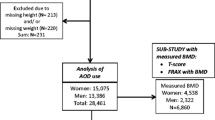Abstract
To assess the number of anti-osteoporosis treatments that would be reimbursed by the Belgian social security if either FRAX® or the current criteria were used to determine access to reimbursement. This is a retrospective study based on data from 1,000 women randomly selected from an outpatient hospital specialized in bone metabolism in Belgium. Proportions of potentially refunded treatments between FRAX® and current criteria were compared. Out of the 1,000 women files, 890 have sufficient information to assess FRAX®. In Belgium, current criteria include a bone mineral density (BMD) T score below −2.5 at the lumbar spine, the femoral neck or the total hip and/or at least a prevalent vertebral fracture. Using these criteria, 167 women (18.8 %) would have access to reimbursement. Using the criteria based on the validated Belgian FRAX® tool, only 116 women (13.0 %) would have access to reimbursement, meaning that access to reimbursement based on FRAX® criteria would reduce by 30 % the anti-osteoporosis drug expenses covered by the national social security. Interestingly, only 65 women out of the 116 (56.0 %) selected with the FRAX® criteria were also selected with the current criteria of the national social security. A substantial proportion of individuals that would potentially receive a reimbursement for their treatment using the FRAX® criteria do not have access to any refund for their treatment with the current criteria. Since patients identified with the FRAX® tool are those with the highest risk profile for future fractures, reappraisals of treatment reimbursement guidelines are expected in Belgium.
Similar content being viewed by others
References
Kanis JA, WHO Study Group (1994) Assessment of fracture risk and its application to screening for postmenopausal osteoporosis: synopsis of a WHO report. Osteoporos Int 4:368–381
Kanis JA, Burlet N, Cooper C, Delmas PD, Reginster JY, Borgstrom F, Rizzoli R (2008) European guidance for the diagnosis and management of osteoporosis in postmenopausal women. Osteoporos Int 19:399–428
Kanis JA, McCloskey EV, Johansson H, Oden A, Strom O, Borgstrom F (2010) Development and use of FRAX in osteoporosis. Osteoporos Int 21 (Suppl 2):S407–413
Kanis JA, Johnell O, De Laet C, Jonsson B, Oden A, Ogelsby AK (2002) International variations in hip fracture probabilities: implications for risk assessment. J Bone Miner Res 17:1237–1244
Johansson H, Kanis JA, McCloskey EV, Oden A, Devogelaer JP, Kaufman JM, Neuprez A, Hiligsmann M, Bruyere O, Reginster JY (2011) A FRAX(R) model for the assessment of fracture probability in Belgium. Osteoporos Int 22(2):453–461
Neuprez A, Johansson H, Kanis JA, McCloskey EV, Oden A, Bruyere O, Hiligsmann M, Devogelaer JP, Kaufman JM, Reginster JY (2009) A FRAX model for the assessment of fracture probability in Belgium. Rev Med Liege 64:612–619
Johansson H, Kanis JA, McCloskey EV, Oden A, Devogelaer JP, Kaufman JM, Neuprez A, Hiligsmann M, Bruyere O, Reginster JY (2011) A FRAX(R) model for the assessment of fracture probability in Belgium. Osteoporos Int 22:453–461
Compston J, Cooper A, Cooper C, Francis R, Kanis JA, Marsh D, McCloskey EV, Reid DM, Selby P, Wilkins M (2009) Guidelines for the diagnosis and management of osteoporosis in postmenopausal women and men from the age of 50 years in the UK. Maturitas 62:105–108
Borgstrom F, Strom O, Coelho J, Johansson H, Oden A, McCloskey EV, Kanis JA (2010) The cost-effectiveness of risedronate in the UK for the management of osteoporosis using the FRAX. Osteoporos Int 21:495–505
Borgstrom F, Strom O, Kleman M, McCloskey E, Johansson H, Oden A, Kanis JA (2011) Cost-effectiveness of bazedoxifene incorporating the FRAX(R) algorithm in a European perspective. Osteoporos Int 22(3):955–965
Kanis JA, Johansson H, Oden A, McCloskey EV (2009) Bazedoxifene reduces vertebral and clinical fractures in postmenopausal women at high risk assessed with FRAX. Bone 44:1049–1054
McCloskey EV, Johansson H, Oden A, Kanis JA (2009) From relative risk to absolute fracture risk calculation: the FRAX algorithm. Curr Osteoporos Rep 7:77–83
Strom O, Borgstrom F, Kleman M, McCloskey E, Oden A, Johansson H, Kanis JA (2010) FRAX and its applications in health economics–cost-effectiveness and intervention thresholds using bazedoxifene in a Swedish setting as an example. Bone 47:430–437
Kanis JA, McCloskey EV, Johansson H, Strom O, Borgstrom F, Oden A (2008) Case finding for the management of osteoporosis with FRAX–assessment and intervention thresholds for the UK. Osteoporos Int 19:1395–1408
Tosteson AN, Burge RT, Marshall DA, Lindsay R (2008) Therapies for treatment of osteoporosis in US women: cost-effectiveness and budget impact considerations. Am J Manag Care 14:605–615
Tosteson AN, Melton LJ 3rd, Dawson-Hughes B, Baim S, Favus MJ, Khosla S, Lindsay RL (2008) Cost-effective osteoporosis treatment thresholds: the United States perspective. Osteoporos Int 19:437–447
Lippuner K, Johansson H, Kanis JA, Rizzoli R (2010) FRAX assessment of osteoporotic fracture probability in Switzerland. Osteoporos Int 21:381–389
Adler RA, Hastings FW, Petkov VI (2010) Treatment thresholds for osteoporosis in men on androgen deprivation therapy: T-score versus FRAX. Osteoporos Int 21:647–653
Conflict of interest
The authors declare that they have no conflict of interest.
Author information
Authors and Affiliations
Corresponding author
Rights and permissions
About this article
Cite this article
Bruyère, O., Fossi, M., Zegels, B. et al. Comparison of the proportion of patients potentially treated with an anti-osteoporotic drug using the current criteria of the Belgian national social security and the new suggested FRAX® criteria. Rheumatol Int 33, 973–978 (2013). https://doi.org/10.1007/s00296-012-2460-y
Received:
Accepted:
Published:
Issue Date:
DOI: https://doi.org/10.1007/s00296-012-2460-y




